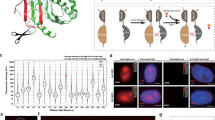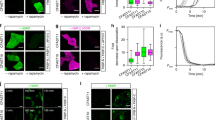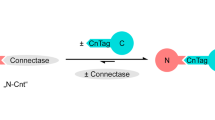Abstract
The visualization of protein complexes in living cells enables the examination of protein interactions in their normal environment and the determination of their subcellular localization. The bimolecular fluorescence complementation assay has been used to visualize interactions among multiple proteins in many cell types and organisms. Modified forms of this assay have been used to visualize the competition between alternative interaction partners and the covalent modification of proteins by ubiquitin-family peptides.
This is a preview of subscription content, access via your institution
Access options
Subscribe to this journal
Receive 12 print issues and online access
$189.00 per year
only $15.75 per issue
Buy this article
- Purchase on Springer Link
- Instant access to full article PDF
Prices may be subject to local taxes which are calculated during checkout



Similar content being viewed by others
References
Zhang, J., Campbell, R. E., Ting, A. Y. & Tsien, R. Y. Creating new fluorescent probes for cell biology. Nature Rev. Mol. Cell Biol. 3, 906?918 (2002).
Jares-Erijman, E. A. & Jovin, T. M. FRET imaging. Nature Biotechnol. 21, 1387?1395 (2003).
Miyawaki, A. Visualization of the spatial and temporal dynamics of intracellular signaling. Dev. Cell 4, 295?305 (2003).
Hu, C. D., Chinenov, Y. & Kerppola, T. K. Visualization of interactions among bZIP and Rel family proteins in living cells using bimolecular fluorescence complementation. Mol. Cell 9, 789?798 (2002).
Hu, C. D. & Kerppola, T. K. Simultaneous visualization of multiple protein interactions in living cells using multicolor fluorescence complementation analysis. Nature Biotechnol. 21, 539?545 (2003).
Brock, R. & Jovin, T. M. Fluorescence correlation microscopy (FCM)-fluorescence correlation spectroscopy (FCS) taken into the cell. Cell. Mol. Biol. 44, 847?856 (1998).
Zhang, S. F., Ma, C. & Chalfie, M. Combinatorial marking of cells and organelles with reconstituted fluorescent proteins. Cell 119, 137?144 (2004).
Cabantous, S., Terwilliger, T. C. & Waldo, G. S. Protein tagging and detection with engineered self-assembling fragments of green fluorescent protein. Nature Biotechnol. 23, 102?107 (2005).
Deppmann, C. D., Thornton, T. M., Utama, F. E. & Taparowsky, E. J. Phosphorylation of BATF regulates DNA binding: a novel mechanism for AP-1 (activator protein-1) regulation. Biochem. J. 374, 423?431 (2003).
Grinberg, A. V., Hu, C. D. & Kerppola, T. K. Visualization of Myc/Max/Mad family dimers and the competition for dimerization in living cells. Mol. Cell. Biol. 24, 4294?4308 (2004).
Rajaram, N. & Kerppola, T. K. Synergistic transcription activation by Maf and Sox and their subnuclear localization are disrupted by a mutation in Maf that causes cataract. Mol. Cell. Biol. 24, 5694?5709 (2004).
Zhu, L. Q. et al. Inhibition of Mist1 homodimer formation induces pancreatic acinar-to-ductal metaplasia. Mol. Cell. Biol. 24, 2673?2681 (2004).
Kanno, T. et al. Selective recognition of acetylated histones by bromodomain proteins visualized in living cells. Mol. Cell 13, 33?43 (2004).
Farina, A. et al. Bromodomain protein Brd4 binds to GTPase-activating SPA-1, modulating its activity and subcellular localization. Mol. Cell. Biol. 24, 9059?9069 (2004).
Diaz, I., Martinez, M., Isabel-LaMoneda, I., Rubio-Somoza, I. & Carbonero, P. The DOF protein, SAD, interacts with GAMYB in plant nuclei and activates transcription of endosperm-specific genes during barley seed development. Plant J. 42, 652?662 (2005).
Jang, M. K. et al. The bromodomain protein Brd4 is a positive regulatory component of P-TEFb and stimulates RNA polymerase II-dependent transcription. Mol. Cell. 19, 523?534 (2005).
Laricchia-Robbio, L. et al. Partner-regulated interaction of IFN regulatory factor 8 with chromatin visualized in live macrophages. Proc. Natl Acad. Sci. USA 102, 14368?14373 (2005).
von der Lehr, N. et al. The F-Box protein Skp2 participates in c-Myc proteosomal degradation and acts as a cofactor for c-Myc-regulated transcription. Mol. Cell. 11, 1189?1200 (2003).
de Virgilio, M., Kiosses, W. B. & Shattil, S. J. Proximal, selective, and dynamic interactions between integrin αIIbβ3 and protein tyrosine kinases in living cells. J. Cell Biol. 165, 305?311 (2004).
Blondel, M. et al. Degradation of Hof1 by SCFGrr1 is important for actomyosin contraction during cytokinesis in yeast. EMBO J. 24, 1440?1452 (2005).
Niu, T. K., Pfeifer, A. C., Lippincott-Schwartz, J. & Jackson, C. L. Dynamics of GBF1, a brefeldin A-sensitive Arf1 exchange factor at the Golgi. Mol. Biol. Cell 16, 1213?1222 (2005).
Remy, I., Montmarquette, A. & Michnick, S. W. PKB/Akt modulates TGF-β signalling through a direct interaction with Smad3. Nature Cell Biol. 6, 358?365 (2004).
Stolpe, T. et al. In planta analysis of protein?protein interactions related to light signaling by bimolecular fluorescence complementation. Protoplasma 226, 137?146 (2005).
Hynes, T. R., Mervine, S. M., Yost, E. A., Sabo, J. L. & Berlot, C. H. Live cell imaging of Gs and the β2-adrenergic receptor demonstrates that both αs and β1γ 7 internalize upon stimulation and exhibit similar trafficking patterns that differ from that of the β2-adrenergic receptor. J. Biol. Chem. 279, 44101?44112 (2004).
Guo, Y. J., Rebecchi, M. & Scarlata, S. Phospholipase C β2 binds to and inhibits phospholipase C δ1 . J. Biol. Chem. 280, 1438?1447 (2005).
Ozalp, C., Szczesna-Skorupa, E. & Kemper, B. Bimolecular fluorescence complementation analysis of cytochrome P450 2C2, 2E1, and NADPH?cytochrome P450 reductase molecular interactions in living cells. Drug Metab. Dispos. 33, 1382?1390 (2005).
Giese, B. et al. Dimerization of the cytokine receptors gp130 and LIFR analysed in single cells. J. Cell Sci. 118, 5129?5140 (2005).
Hynes, T. R. et al. Visualization of G protein βγ dimers using bimolecular fluorescence complementation demonstrates roles for both β and γ in subcellular targeting. J. Biol. Chem. 279, 30279?30286 (2004).
Takahashi, Y. et al. Loss of Bif-1 suppresses Bax/Bak conformational change and mitochondrial apoptosis. Mol. Cell. Biol. 25, 9369?9382 (2005).
Nyfeler, B., Michnick, S. W. & Hauri, H. P. Capturing protein interactions in the secretory pathway of living cells. Proc. Natl Acad. Sci. USA 102, 6350?6355 (2005).
Rackham, O. & Brown, C. M. Visualization of RNA-protein interactions in living cells: FMRP and IMP1 interact on mRNAs. EMBO J. 23, 3346?3355 (2004).
Stains, C. I., Porter, J. R., Ooi, A. T., Segal, D. J. & Ghosh, I. DNA sequence-enabled reassembly of the green fluorescent protein. J. Am. Chem. Soc. 127, 10782?10783 (2005).
Remy, I. & Michnick, S. W. Regulation of apoptosis by the Ft1 protein, a new modulator of protein kinase B/Akt. Mol. Cell. Biol. 24, 1493?1504 (2004).
Shyu, Y. J., Liu, H., Deng, X. & Hu, C. D. Identification of new fluorescent protein fragments for bimolecular fluorescence complementation analysis under physiological conditions. BioTechniques 40, 61?66 (2006).
Fang, D. Y. & Kerppola, T. K. Ubiquitin-mediated fluorescence complementation reveals that Jun ubiquitinated by Itch/AIP4 is localized to lysosomes. Proc. Natl Acad. Sci. USA 101, 14782?14787 (2004).
Magliery, T. J. et al. Detecting protein?protein interactions with a green fluorescent protein fragment reassembly trap: scope and mechanism. J. Am. Chem. Soc. 127, 146?157 (2005).
Richards, F. M. On the enzymic activity of subtilisin-modified ribonuclease. Proc. Natl Acad. Sci. USA 44, 162?166 (1958).
Ullmann, A., Perrin, D., Jacob, F. & Monod, J. Identification par complémentation in vitro et purification d'un segment peptidique de la β-galactosidase d' Escherichia coli. J. Mol. Biol. 12, 918?923. (1965).
Rossi, F., Charlton, C. A. & Blau, H. M. Monitoring protein?protein interactions in intact eukaryotic cells by βgalactosidase complementation. Proc. Natl Acad.Sci. USA 94, 8405?8410 (1997).
Johnsson, N. & Varshavsky, A. Split ubiquitin as a sensor of protein interactions in vivo. Proc. Natl Acad. Sci. USA 91, 10340?10344 (1994).
Pelletier, J. N., Campbell-Valois, F. X. & Michnick, S. W. Oligomerization domain-directed reassembly of active dihydrofolate reductase from rationally designed fragments. Proc. Natl Acad. Sci. USA 95, 12141?12146 (1998).
Ghosh, I., A. D. Hamilton, and L. Regan . Antiparallel leucine zipper-directed protein reassembly: application to the green fluorescent protein. J. Am. Chem. Soc 122, 5658?5659 (2000).
Hoff, B. & Kuck, U. Use of bimolecular fluorescence complementation to demonstrate transcription factor interaction in nuclei of living cells from the filamentous fungus Acremonium chrysogenum. Curr. Genet. 47, 132?138 (2005).
Atmakuri, K., Ding, Z. Y. & Christie, P. J. VirE2, a type IV secretion substrate, interacts with the VirD4 transfer protein at cell poles of Agrobacterium tumefaciens A1. Mol. Microbiol. 49, 1699?1713 (2003).
Tzfira, T., Vaidya, M. & Citovsky, V. Involvement of targeted proteolysis in plant genetic transformation by Agrobacterium. Nature 431, 87?92 (2004).
Loyter, A. et al. The plant VirE2 interacting protein 1. A molecular link between the Agrobacterium T-complex and the host cell chromatin? Plant Physiol. 138, 1318?1321 (2005).
Lacroix, B., Vaidya, M., Tzfira, T. & Citovsky, V. The VirE3 protein of Agrobacterium mimics a host cell function required for plant genetic transformation. EMBO J. 24, 428?437 (2005).
Schmidt, C. et al. Mechanisms of proinflammatory cytokine-induced biphasic NF-κB activation. Mol. Cell. 12, 1287?1300 (2003).
Blumenstein, A. et al. The Aspergillus nidulans phytochrome FphA represses sexual development in red light. Curr. Biol. 15, 1833?1838 (2005).
Tsuchisaka, A. & Theologis, A. Heterodimeric interactions among the 1-amino-cyclopropane-1-carboxylate synthase polypeptides encoded by the Arabidopsis gene family. Proc. Natl Acad. Sci. USA 101, 2275?2280 (2004).
Ye, H. H., Choi, H. J., Poe, J. & Smithgall, T. E. Oligomerization is required for HIV-1 nef-induced activation of the Src family protein-tyrosine kinase, Hck. Biochemistry 43, 15775?15784 (2004).
Bracha-Drori, K. et al. Detection of protein?protein interactions in plants using bimolecular fluorescence complementation. Plant J. 40, 419?427 (2004).
Walter, M. et al. Visualization of protein interactions in living plant cells using bimolecular fluorescence complementation. Plant J. 40, 428?438 (2004).
Hackbusch, J., Richter, K., Muller, J., Salamini, F. & Uhrig, J. F. A central role of Arabidopsis thaliana ovate family proteins in networking and subcellular localization of 3-aa loop extension homeodomain proteins. Proc. Natl Acad. Sci. USA 102, 4908?4912 (2005).
Shimizu, H. et al. LIP19, a basic region leucine zipper protein, is a fos-like molecular switch in the cold signaling of rice plants. Plant Cell Physiol. 46, 1623?1634 (2005).
Abe, M. et al. FD, a bZIP protein mediating signals from the floral pathway integrator FT at the shoot apex. Science 309, 1052?1056 (2005).
Maple, J., Aldridge, C. & Moller, S. G. Plastid division is mediated by combinatorial assembly of plastid division proteins. Plant J. 43, 811?823 (2005).
Demidov, V. V. et al. Fast complementation of split fluorescent protein triggered by DNA hybridization. Proc. Natl Acad. Sci. USA 103, 2052?2056 (2006).
Schmidt, U., Richter, K., Berger, A. B. & Lichter, P. In vivo BiFC analysis of Y14 and NXF1 mRNA export complexes: preferential localization within and around SC35 domains. J. Cell Biol. 172, 373?381 (2006).
Cascales, E., Atmakuri, K., Liu, Z., Binns, A. N. & Christie, P. J. Agrobacterium tumefaciens oncogenic suppressors inhibit T-DNA and VirE2 protein substrate binding to the VirD4 coupling protein. Mol. Microbiol. 58, 565?579 (2005).
Author information
Authors and Affiliations
Ethics declarations
Competing interests
The author declares no competing financial interests.
Supplementary information
Related links
Rights and permissions
About this article
Cite this article
Kerppola, T. Visualization of molecular interactions by fluorescence complementation. Nat Rev Mol Cell Biol 7, 449–456 (2006). https://doi.org/10.1038/nrm1929
Published:
Issue Date:
DOI: https://doi.org/10.1038/nrm1929
This article is cited by
-
Pharmacological characterization of the small molecule 03A10 as an inhibitor of α-synuclein aggregation for Parkinson’s disease treatment
Acta Pharmacologica Sinica (2023)
-
Genome-wide CRISPR–Cas9 Knockout Screening Reveals a TSPAN3-mediated Endo-lysosome Pathway Regulating the Degradation of α-Synuclein Oligomers
Molecular Neurobiology (2023)
-
Development of intensiometric indicators for visualizing N-cadherin interaction across cells
Communications Biology (2022)
-
DiB-splits: nature-guided design of a novel fluorescent labeling split system
Scientific Reports (2020)
-
The overexpression of OsSRO1a, which encodes an OsNINJA1- and OsMYC2-interacting protein, negatively affects OsMYC2-mediated jasmonate signaling in rice
Plant Cell Reports (2020)



